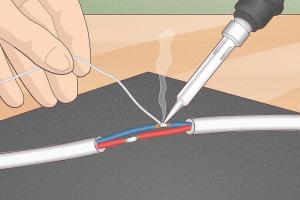Mastering Electric Cord Repair: A Complete Guide to Fixing Your Cords

-
Quick Links:
- Introduction
- Tools Needed for Electric Cord Repair
- Safety Precautions
- Identifying the Problem
- Step-by-Step Repair Guide
- Case Studies and Real World Examples
- Expert Insights on Cord Maintenance
- FAQs
Introduction
Electric cords are a vital part of our everyday lives, powering the devices that keep us connected and productive. However, wear and tear can lead to damaged cords, which not only affects functionality but can also pose safety risks. In this comprehensive guide, we’ll explore how to repair an electric cord effectively, ensuring that you can extend the life of your devices while maintaining safety standards.
Tools Needed for Electric Cord Repair
Before diving into the repair process, it's essential to gather the necessary tools. Here’s a comprehensive list:
- Wire cutters
- Wire strippers
- Screwdrivers (flathead and Phillips)
- Electrical tape
- Heat shrink tubing
- Multimeter
- Utility knife
- Safety glasses
- Work gloves
Safety Precautions
Safety should always be a priority when dealing with electrical repairs. Here are some vital safety tips:
- Always unplug the cord before starting any repairs.
- Wear safety glasses to protect your eyes from debris.
- Use insulated tools to prevent electrical shock.
- Work in a well-lit area to clearly see any damages.
- Be cautious of exposed wires and avoid direct contact.
Identifying the Problem
Understanding the nature of the damage is crucial for effective repair. Common issues include:
- Frayed or exposed wires
- Broken plugs
- Loose connections
- Burn marks or odor
- Inconsistent power delivery
Use a multimeter to check for continuity in the wire. If there is no continuity, this indicates a break somewhere along the wire.
Step-by-Step Repair Guide
1. Assess the Damage
Start by thoroughly inspecting the cord to determine the extent of the damage. Check both the plug and the cord length for any fraying or breaks.
2. Cut Away Damaged Sections
Using wire cutters, carefully cut out the damaged sections of the cord. Ensure you leave enough length on both sides for proper reconnection.
3. Strip the Wires
Use wire strippers to expose about half an inch of copper wire on each end. Be gentle to avoid damaging the wire itself.
4. Connect the Wires
Twist the exposed wire ends together, ensuring that they are tightly connected. If you are connecting different colored wires, refer to the device's wiring diagram.
5. Insulate the Connection
Wrap electrical tape around the twisted wires to prevent any exposure. For extra protection, slide heat shrink tubing over the connection and apply heat to shrink it tightly around the wires.
6. Test the Repair
Plug the cord back into the outlet and test it with a multimeter to ensure it’s functioning correctly. Look for any signs of overheating or sparking.
7. Final Inspection
Once tested, do a final inspection of the cord to ensure everything is secure and insulated properly.
Case Studies and Real World Examples
Case Study 1: Repairing a Frayed Laptop Charger
A common scenario involves a frayed laptop charger. After identifying the fraying, a user cut out the damaged section, twisted the wires, and insulated them with electrical tape. The repair was successful, and the charger continued to function without issues.
Case Study 2: Fixing a Broken Power Tool Cord
An electrician encountered a broken cord on a power tool. By following the step-by-step guide, they were able to replace the entire plug, ensuring the tool was safe to use again.
Expert Insights on Cord Maintenance
To prolong the life of your electric cords, consider these expert tips:
- Regularly inspect cords for wear and tear.
- Avoid overloading outlets to prevent overheating.
- Store cords properly to prevent tangling and damage.
- Use cord covers when running cords across high-traffic areas.
FAQs
1. Can I repair any electric cord?
Most electric cords can be repaired if the damage is not severe. However, if the cord has significant damage or if it’s a high-voltage cord, it’s best to replace it.
2. How do I know if my cord is unsafe to use?
Signs of unsafe cords include fraying, burn marks, an unusual odor, or if the cord feels hot to the touch.
3. Is it safe to use electrical tape for repairs?
Yes, electrical tape is designed for electrical repairs and can safely insulate connections if applied correctly.
4. What should I do if I don’t have all the tools needed?
If you lack the necessary tools, consider purchasing a basic electrical repair kit, which typically includes everything you need.
5. How often should I inspect my electrical cords?
It’s a good practice to inspect cords every few months, especially for frequently used devices.
6. Can I use duct tape instead of electrical tape?
No, duct tape is not suitable for electrical repairs as it does not provide adequate insulation and can lead to safety hazards.
7. What is heat shrink tubing?
Heat shrink tubing is a type of plastic tubing that shrinks in diameter when heated, providing insulation and protection for electrical connections.
8. Can I repair a broken plug?
Yes, broken plugs can often be replaced or repaired by following a similar process to cord repair.
9. What are some common types of electrical cords I might repair?
Common types include extension cords, laptop chargers, power tool cords, and appliance cords.
10. When should I consider replacing a cord instead of repairing it?
If the cord has multiple damaged areas, severe burns, or if it’s an integral part of a safety device, it’s better to replace it.
Repairing an electric cord can save you money and extend the life of your devices, but safety should always come first. By following this guide, you can confidently tackle repairs while ensuring that you remain cautious and informed.